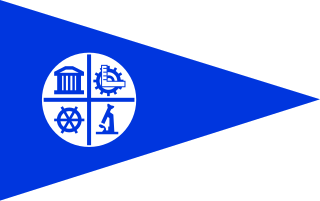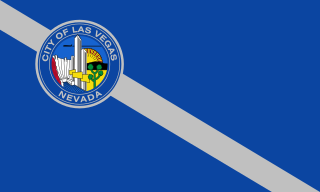
The official flag of Minnesota consists of a dark blue field representing the night sky and the shape of the state, a bright blue field representing the state's abundant waters, and an eight-pointed star representing the North Star using a design prominently featured at the Minnesota State Capitol.

The Cathedral of Saint Paul is a Roman Catholic cathedral in the city of Saint Paul, Minnesota. It is the co-cathedral of the Archdiocese of Saint Paul and Minneapolis, along with the Basilica of Saint Mary in Minneapolis. One of the most distinctive cathedrals in the United States, it sits on Cathedral Hill overlooking downtown Saint Paul and features a distinctive copper-clad dome. It is dedicated to Paul the Apostle, who is also the namesake of the City of Saint Paul. The current building opened in 1915 as the fourth cathedral of the archdiocese to bear this name. On March 25, 2009, it was designated as the National Shrine of the Apostle Paul by the United States Conference of Catholic Bishops. It is the third-largest Catholic cathedral and sixth-largest church in the United States.

The flag of Minneapolis is the official municipal flag of Minneapolis, Minnesota.

The city flag of Los Angeles consists of a background of three notched stripes of green, gold and red. The flag was designed by Roy E. Silent and E.S. Jones in 1931 for the Los Angeles sesquicentennial from 1781.

The flag of Birmingham was designed by Idyl King Sorsby for the occasion of the semicentennial of the city of Birmingham, Alabama in 1921. The flag was officially adopted as the city's flag on August 18, 1925.

The flag of Denver is the official flag of the City and County of Denver in Colorado. It was designed by a North High School student, Margaret Overbeck, and adopted in 1926. A zigzag white stripe horizontally separates a red field below from a blue field above, in which is centered a yellow circle, together forming a stylized depiction of the Sun in a blue sky above snow-capped mountains. The color yellow symbolizes gold in the state's hills, and red the colored earth to which the word colorado refers. The circle's centered position symbolizes Denver's central location within the state. The white zigzag symbolizes Colorado's Native American heritage.

The flag of Las Vegas, consists of blue field with a diagonal gray stripe running from the top of the hoist to the bottom of the fly. Las Vegas' city seal, adopted on March 16, 1966 and designed by Richard Thompson, is located in the canton breaking the stripe.

The flag of St. Louis, Missouri, consists of a solid red background and three thick, wavy lines colored blue and white extending from the top left corner, bottom left corner, and center right edge. At the intersection of these lines there is a yellow disk containing a blue fleur-de-lis.

The current flag of Billings, Montana, United States, is a "Canadian-like" triband of very dark blue and white with the city seal on the central white panel. The seal shows the Billings skyline line-drawn in blue, with a red disc representing the sun. The seal is outlined in blue with the text "Star of the Big Sky Country" in red capitals. It was designed by Fernando Méndez and adopted in June 1986.

The flag of Fort Wayne, Indiana, was adopted as the city's official flag by City Council on June 26, 1934. The pall design includes two diagonal white stripes converging in the circular center to form a horizontal white stripe. Red silhouettes of a Miami Native American head, a French fleur-de-lis, and a British lion grace a navy blue field. A red blockhouse is located at the center of the converging stripes, with the settlement's founding date and city name.

The flag of Tulsa consists of an upper navy blue half and a lower beige half, separated by a gold horizontal line, with a gold Osage shield punctuating the left third. The shield contains a red circle, and a beige six-pointed star centered within the circle. The flag is notable for being one of the few modern flags to utilize beige in its design - a color often associated with faded dyes on flags from usage.

The flag of San Jose is the official municipal flag of San Jose, California. The current design, a triband of gold on top, white in the middle, and blue on the bottom with the city's official seal in the center, has been the official flag since 1984.

The flag of Austin is the official municipal flag of Austin, Texas. The flag simply consists of a white field with the seal of Austin without the surrounding circle of text. Below the seal of Austin is the text "CITY OF AUSTIN", written in blue and arched upwards.

The flag of Columbus is the official municipal flag of Columbus, Ohio. Its current design is a yellow, white, red vertical triband with the city seal on a blue field. Officially, the flag was adopted in 1929, although it is unknown if the flag was ever flown when it was first adopted.

The flag of Raleigh is the official municipal flag of Raleigh, North Carolina. It is one of the few American city flags to currently feature different designs on the obverse and reverse. Both sides feature a similar red-white-red vertical triband with an emblem in the center. The obverse features the Seal of Raleigh. The reverse has a modified version of the coat of arms of Sir Walter Raleigh.

The flag of South Bend, Indiana, was adopted by the city council during the mayorship of Pete Buttigieg on April 25, 2016. It is a field of white and yellow separated by a two blue curved lines with a white line between them and a red six-pointed star in the upper left corner.

The flag of Anchorage, Alaska, was adopted by the city of Anchorage in 1973. It is a field of yellow with the seal of the city, which features a blue anchor in the foreground as well as a blue airplane, yellow sun, and yellow sailboat in the background. The words "ANCHORAGE ALASKA" are also present.

The flag of Burlington, Vermont was adopted by the Burlington city council on November 27, 2017 during the mayorship of Miro Weinberger. It is five horizontal, zig-zag stripes of blue, white, green, white, and blue.

The flag of Pocatello is the official flag of the city of Pocatello, Idaho, United States. The present flag was adopted on July 20, 2017, replacing the previous flag, used unofficially from 2001 to 2017. The former flag was considered by a 2004 survey of the North American Vexillological Association to be the worst of 150 selected US city flags. The current flag is commonly known as the Mountains Left, while the previous flag was known as the Proud to be Pocatello.




















